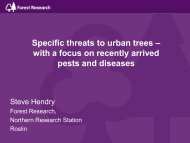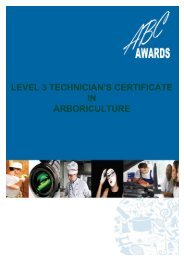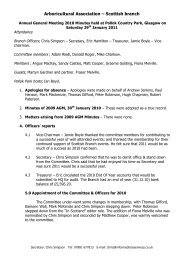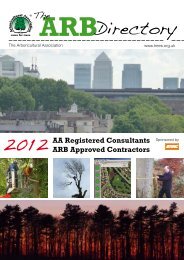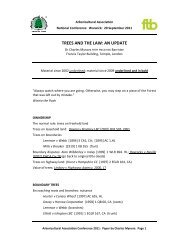BS5837: 2012 Trees in relation to design, demolition - Arboricultural ...
BS5837: 2012 Trees in relation to design, demolition - Arboricultural ...
BS5837: 2012 Trees in relation to design, demolition - Arboricultural ...
You also want an ePaper? Increase the reach of your titles
YUMPU automatically turns print PDFs into web optimized ePapers that Google loves.
<strong>BS5837</strong>: <strong>2012</strong> <strong>Trees</strong> <strong>in</strong> <strong>relation</strong> <strong>to</strong> <strong>design</strong>, <strong>demolition</strong> and construction<br />
AA Road show presentation notes: Richard Nicholson May-July <strong>2012</strong><br />
Edited by Mike Sankus<br />
The BS Review Group comprised:<br />
ñ� Ian Phillips Landscape Architect;<br />
ñ� Clive Entwistle, Eng<strong>in</strong>eer;<br />
ñ� Mike Volp, <strong>Arboricultural</strong> Officer LPA;<br />
ñ� Jim Smith, Arboriculturist. With the Tree Design Action Group;<br />
ñ� Mick Boddy, <strong>Arboricultural</strong> Consultant;<br />
ñ� Julian Forbes-Laird, <strong>Arboricultural</strong> Consultant.<br />
<strong>BS5837</strong>:2005 had been tested <strong>in</strong> various forums which helped the Review Group prepare<br />
a draft document for public consultation. The review group looked at what had worked and<br />
what had not and amended the document accord<strong>in</strong>gly, add<strong>in</strong>g entirely new sections <strong>to</strong> the<br />
first draft where relevant. Forums <strong>in</strong>cluded:<br />
ñ� Plann<strong>in</strong>g meet<strong>in</strong>gs,<br />
ñ� Pre application meet<strong>in</strong>gs<br />
ñ� LPA recommendations<br />
ñ� Consultant recommendations<br />
ñ� Exam<strong>in</strong>ation at appeal<br />
What worked What didn’t<br />
Flow process.<br />
Figure 1 s<strong>to</strong>pped cherry pick<strong>in</strong>g <strong>to</strong><br />
a certa<strong>in</strong> extent and set out a<br />
process<br />
Tree survey first<br />
Cascade Chart for tree<br />
classification was appreciated by<br />
non-arboriculturists, e.g. Plann<strong>in</strong>g<br />
Inspec<strong>to</strong>rs as it saved arguments<br />
amongst arboriculturists about<br />
different systems<br />
RPA as an area was unders<strong>to</strong>od<br />
as was the idea of adjustment <strong>to</strong><br />
suit site conditions<br />
Constra<strong>in</strong>ts mapp<strong>in</strong>g, useful <strong>to</strong><br />
represent the 3D tree <strong>in</strong> 2D and<br />
issues about liveability<br />
Section 13 'Design considerations<br />
for new plant<strong>in</strong>g.' Use of landscape<br />
architect and <strong>design</strong> advice for new<br />
schemes.<br />
Mitigation plant<strong>in</strong>g<br />
Flow process became a sequence of<br />
discrete steps, which were almost an<br />
end <strong>in</strong> themselves. Tick boxes not the<br />
process<br />
‘R’, which was frequently confused<br />
with mean<strong>in</strong>g remove or reta<strong>in</strong>?<br />
Became ‘U’<br />
Multi stemmed trees calculation did<br />
not work<br />
‘open grown’ not expla<strong>in</strong>ed properly <strong>in</strong><br />
the text<br />
Overzealous use of sunlight<br />
arguments. Its rarely a ‘no’<br />
Sunlight only, rather than sunlight and<br />
daylight was taken <strong>in</strong><strong>to</strong> account<br />
Tree Constra<strong>in</strong>ts Plan became an<br />
entity required by LPA.<br />
<strong>Arboricultural</strong> Method Statement
<strong>BS5837</strong>: <strong>2012</strong> <strong>Trees</strong> <strong>in</strong> <strong>relation</strong> <strong>to</strong> <strong>design</strong>, <strong>demolition</strong> and construction<br />
AA Road show presentation notes: Richard Nicholson May-July <strong>2012</strong><br />
Edited by Mike Sankus<br />
Protect<strong>in</strong>g areas of the site from<br />
construction activity that are<br />
reserved for new plant<strong>in</strong>g<br />
Type of fenc<strong>in</strong>g, more realistic and<br />
the use of ground protection<br />
3D cellular conf<strong>in</strong>ement systems<br />
better than 2D<br />
Statements about details <strong>in</strong><br />
subsequent draw<strong>in</strong>gs<br />
became process driven or worse still,<br />
formulaic. What is the objective?<br />
CEZ just another TLA? Muddled<br />
description was not helpful.<br />
Figure 3<br />
Fence diagram Fig 2 poorly drawn<br />
and <strong>to</strong>o prescriptive<br />
RPA def<strong>in</strong>ition<br />
Section 11 advice <strong>to</strong> builders, now<br />
<strong>in</strong>cluded <strong>in</strong> an <strong>in</strong>formative annex<br />
3m or 20% references were muddled<br />
so the 3m reference was dropped<br />
Title<br />
The new title reflects the entire development process. Construction is def<strong>in</strong>ed as site-based<br />
operations, but the consideration of trees on a development site needs <strong>to</strong> start before then.<br />
Demolition frequently occurs before plann<strong>in</strong>g consent is sought or granted, subject <strong>to</strong><br />
plann<strong>in</strong>g conditions.<br />
Foreword.<br />
<strong>BS5837</strong>: <strong>2012</strong> came <strong>in</strong><strong>to</strong> effect on 30 April <strong>2012</strong>. BS 5837: 2005 was withdrawn the same<br />
day. Figure 2 and figure 3 of the new standard (fenc<strong>in</strong>g details) can be reproduced without<br />
<strong>in</strong>fr<strong>in</strong>g<strong>in</strong>g copyright.<br />
Use of the document<br />
Execution of its provisions is standard British Standard word<strong>in</strong>g for all standards.<br />
Introduction<br />
Benefits of trees highlighted and for the first time the term ‘Green Infrastructure’ is <strong>in</strong>cluded.<br />
The importance of trees as 'material considerations' <strong>in</strong> the plann<strong>in</strong>g process is highlighted.<br />
Mentions that level of detail required will vary from plann<strong>in</strong>g application <strong>to</strong> plann<strong>in</strong>g<br />
application. Aligns with government advice on validation of plann<strong>in</strong>g applications.<br />
Figure 1 sets out the process based on RIBA work stages and sets out the ma<strong>in</strong> chapter<br />
head<strong>in</strong>gs <strong>in</strong> the standard, us<strong>in</strong>g a similar language. For example section 5 has Conception;<br />
Section 6 has Design and Technical.<br />
Section 1 - Scope
<strong>BS5837</strong>: <strong>2012</strong> <strong>Trees</strong> <strong>in</strong> <strong>relation</strong> <strong>to</strong> <strong>design</strong>, <strong>demolition</strong> and construction<br />
AA Road show presentation notes: Richard Nicholson May-July <strong>2012</strong><br />
Edited by Mike Sankus<br />
BS 5837:<strong>2012</strong> applies whether or not plann<strong>in</strong>g permission is needed. For example,<br />
permitted development.<br />
Section 3 – Terms and def<strong>in</strong>itions<br />
Paragraph 3.1 - Access facilitation prun<strong>in</strong>g is limited by the need <strong>to</strong> ensure prun<strong>in</strong>g works<br />
do not have a significant adverse impact on reta<strong>in</strong>ed trees and are limited <strong>to</strong> what is<br />
necessary for access only.<br />
Paragraph 3.2 – There is a better def<strong>in</strong>ition of the <strong>Arboricultural</strong> Method Statement, which is<br />
needed for any aspect of development, <strong>in</strong>clud<strong>in</strong>g <strong>demolition</strong>, where it lies with<strong>in</strong> the RPA.<br />
No def<strong>in</strong>ition of Tree Constra<strong>in</strong>ts Plan, but there is a statement about plott<strong>in</strong>g constra<strong>in</strong>ts on<br />
relevant draw<strong>in</strong>gs <strong>in</strong> paragraph 5.2 <strong>to</strong> reflect the importance of this part of the process.<br />
Paragraph 3.7 – There is a better def<strong>in</strong>ition of the Root Protection Area, which treats the<br />
protection of roots and soil structure as a priority. RPA is just about the only abbreviation <strong>in</strong><br />
the standard.<br />
Section 4 - Feasibility: surveys and prelim<strong>in</strong>ary constra<strong>in</strong>ts<br />
Paragraph 4.1 – There is <strong>in</strong>formation about scales and copy<strong>in</strong>g of plans, the use of a scale<br />
bar and monochrome statements.<br />
Paragraph 4.3.1 - Soil assessment. This was <strong>in</strong>cluded at the request of eng<strong>in</strong>eers and<br />
landscape architects. This is not necessarily a detailed survey and may not be undertaken<br />
by the arboriculturist, but must be fit for purpose.<br />
In some circumstances the soil assessment could result <strong>in</strong> a larger RPA than that<br />
prescribed <strong>in</strong> Annex D for a given stem diameter.<br />
Paragraph 4.4.1.1- Concerns the tim<strong>in</strong>g of tree surveys <strong>to</strong> ensure it is available <strong>to</strong> <strong>design</strong>ers<br />
prior <strong>to</strong> formulat<strong>in</strong>g <strong>design</strong> proposals.<br />
Paragraph 4.4.1.3 – There is new advice for Local Plann<strong>in</strong>g Authorities about not rely<strong>in</strong>g on<br />
plann<strong>in</strong>g conditions <strong>to</strong> secure a tree survey. The tree survey is an important part of the<br />
evidence base used at the <strong>design</strong> feasibility stage and must form part of the plann<strong>in</strong>g<br />
application at validation.<br />
Paragraph 4.4.2.2 – With<strong>in</strong> the context of proposed development. This is about land use<br />
allocations and pr<strong>in</strong>ciples of types of development as def<strong>in</strong>ed <strong>in</strong> local plans (see National<br />
Plann<strong>in</strong>g Policy Framework). For example, residential, golf course etc. It is NOT the details<br />
of a particular development <strong>design</strong> for a site that forms part of an outl<strong>in</strong>e or detailed<br />
plann<strong>in</strong>g application.<br />
Paragraph 4.4.2.4 – This is new advice on the management of trees with<strong>in</strong> groups<br />
Paragraph 4.4.2.6 - Concerns measurement conventions. BS uses SI units
<strong>BS5837</strong>: <strong>2012</strong> <strong>Trees</strong> <strong>in</strong> <strong>relation</strong> <strong>to</strong> <strong>design</strong>, <strong>demolition</strong> and construction<br />
AA Road show presentation notes: Richard Nicholson May-July <strong>2012</strong><br />
Edited by Mike Sankus<br />
Paragraph 4.4.2.9 – Provides <strong>in</strong>formation about shr<strong>in</strong>kable soils and hedgerows. This was<br />
added at request of eng<strong>in</strong>eers<br />
Paragraphs 4.5.3 & 4.5.7 - Tree categorisation no longer uses R as a tree grade and<br />
<strong>in</strong>cludes U <strong>in</strong>stead. The reason for us<strong>in</strong>g U and not R is that it removes any assumption that<br />
R = Remove.<br />
Paragraph 4.5.4 - Generally the same weight is accrued for each subcategory as before<br />
(see below). The sentence "would not accrue added value" was present <strong>in</strong> BS 5837:2005,<br />
but is no longer <strong>in</strong> the text. Effectively it’s the same as it was, but the Note is <strong>in</strong> the wrong<br />
place <strong>in</strong> the process.<br />
The note <strong>in</strong> BS 5837:2005 at the end of the table: "Whilst category C trees will usually not<br />
be reta<strong>in</strong>ed where they would impose a significant constra<strong>in</strong>t on development, young trees<br />
with a stem diameter of less than 150mm should be considered for location" has been<br />
taken out of the standard and does not appear <strong>in</strong> <strong>BS5837</strong>: <strong>2012</strong> because Table 1 is about<br />
gather<strong>in</strong>g the data <strong>in</strong> order <strong>to</strong> make decisions, not about condemn<strong>in</strong>g a tree before all the<br />
data has been gathered.<br />
Paragraph 4.5.7 - Upgraded means it’s a U grade tree, based on 3 bullets, but its<br />
conservation, heritage, landscape or cultural values make a case for it <strong>to</strong> be upgraded <strong>to</strong> a<br />
C grade tree for the short term. This of course is subject <strong>to</strong> the safety issues also mentioned<br />
<strong>in</strong> this paragraph.<br />
Paragraph 4.5.8 - The reference <strong>to</strong> irremediable diseases applies <strong>to</strong> serious ailments, which<br />
have a significant impact on the safety of a tree <strong>in</strong> the short term. For example Inonotus on<br />
Plane or nail galls on a Lime shouldn’t downgrade a tree which would otherwise be graded<br />
A, B or C <strong>to</strong> a U grade tree. The same logic applies <strong>to</strong> the third bullet po<strong>in</strong>t under U grade<br />
trees <strong>in</strong> Table 1<br />
Table 1 - Rema<strong>in</strong><strong>in</strong>g life expectancy is used <strong>in</strong> BS 5837:<strong>2012</strong>, rather than ‘substantial’ or<br />
'significant' contribution as <strong>in</strong> set out <strong>in</strong> <strong>BS5837</strong>: 2005. <strong>Trees</strong> can contribute when they are<br />
dead. <strong>Trees</strong> graded A , B or C are largely about trees that are not dead.<br />
OED Def<strong>in</strong>itions –<br />
Quality: Dist<strong>in</strong>guish<strong>in</strong>g characteristic, the character or nature of someth<strong>in</strong>g.<br />
Value: Desirability <strong>in</strong> respect of some property.<br />
Paragraph 4.5.10 - Young trees were raised as be<strong>in</strong>g important by the review group <strong>in</strong> DPC<br />
but there was no support for this view so it was removed.<br />
Paragraph 4.5.11 – There is a def<strong>in</strong>ition of veteran <strong>in</strong> paragraph 3.12 which is taken from<br />
BS 3998: 2010. The importance of veteran and ancient trees is highlighted here. Both are<br />
classed as A3 grade trees because there was a feel<strong>in</strong>g that an ancient, largely dead tree<br />
could, under <strong>BS5837</strong>: 2005 could <strong>to</strong>o easily be classified as an R grade tree.
<strong>BS5837</strong>: <strong>2012</strong> <strong>Trees</strong> <strong>in</strong> <strong>relation</strong> <strong>to</strong> <strong>design</strong>, <strong>demolition</strong> and construction<br />
AA Road show presentation notes: Richard Nicholson May-July <strong>2012</strong><br />
Edited by Mike Sankus<br />
Paragraph 4.6.1 – The RPA refers <strong>to</strong> Annex D, which provides the radius based on<br />
measured stem diameter @1.5m. It saves the calculation and prevents ridiculous RPA's<br />
with <strong>to</strong>o many decimal places. It was requested at public consultation.<br />
The draw<strong>in</strong>gs at Annex C are based on those from Australian National Standard.<br />
Multi stemmed trees are based on cross sectional stem diameter not area.<br />
Paragraph 4.6.2 - The frequently misused term ‘Open grown' found <strong>in</strong> <strong>BS5837</strong>: 2005 has<br />
been removed and replaced with new word<strong>in</strong>g <strong>in</strong> <strong>BS5837</strong>: <strong>2012</strong>.<br />
Paragraph 4.6.3 - The list order has been changed and the phrase ‘when known’ has been<br />
omitted from <strong>BS5837</strong>: <strong>2012</strong>.<br />
Section 5 - Proposals: conception and <strong>design</strong><br />
Paragraph 5.1.2 - Project arboriculturist appears for the first time and stays until section 7<br />
Demolition and construction <strong>in</strong> proximity <strong>to</strong> exist<strong>in</strong>g trees.<br />
Paragraph 5.2.2 – Refers <strong>to</strong> <strong>design</strong>s which should avoid unreasonable obstruction <strong>to</strong> light<br />
and refers <strong>to</strong> BR 209, which is frequently used by planners <strong>to</strong> assess daylight and sunlight<br />
issues. It conta<strong>in</strong>s a specific appendix on trees.<br />
Paragraph 5.2.3 (f) - Solar collec<strong>to</strong>rs are referenced. See Thayer - Solar access and the<br />
urban forest. <strong>Arboricultural</strong> Journal, 1983. Volume 7<br />
Paragraph 5.2.4 – There is a note concern<strong>in</strong>g climate change resilience and the<br />
contribution of large species. Emphasises the need <strong>to</strong> take care at conceptual and <strong>design</strong><br />
stage for successful <strong>in</strong>tegration of healthy trees.<br />
Paragraph 5.3.1 – The head<strong>in</strong>g ‘Proximity of structures <strong>to</strong> trees’ <strong>in</strong> <strong>BS5837</strong>: <strong>2012</strong> replaces<br />
'proximity of trees <strong>to</strong> structures’ <strong>in</strong> 6.3 of <strong>BS5837</strong>: 2005.<br />
There is a new default position, which states that all structures should be sited outside the<br />
RPA of trees <strong>to</strong> be reta<strong>in</strong>ed unless there is an overrid<strong>in</strong>g justification and the project<br />
arboriculturist can demonstrate that it would be acceptable <strong>to</strong> do otherwise.<br />
Paragraph 5.3.2 - The cumulative effects of <strong>in</strong>cursions <strong>in</strong><strong>to</strong> RPAs was only a note at 6.2.3<br />
of <strong>BS5837</strong>: 2005. It is now a significant consideration <strong>in</strong> <strong>BS5837</strong>: <strong>2012</strong>. There is a new<br />
consideration regard<strong>in</strong>g the acceptability of further activity with<strong>in</strong> the RPA.<br />
Paragraph 5.3.4 - Shad<strong>in</strong>g is better def<strong>in</strong>ed and the mix up of sunlight and daylight has<br />
been rectified <strong>in</strong> <strong>BS5837</strong>: <strong>2012</strong>. The benefits of shad<strong>in</strong>g are spelled out better than it was <strong>in</strong><br />
<strong>BS5837</strong>: 2005. See also paragraph 5.2.2.<br />
Sub section 5.4 - <strong>Arboricultural</strong> impact assessment<br />
This is not an implications assessment (new word<strong>in</strong>g). This assessment evaluates the<br />
effects of the proposed <strong>design</strong>, <strong>in</strong>clud<strong>in</strong>g potentially damag<strong>in</strong>g activities such as removal of<br />
exist<strong>in</strong>g structures and the location and dimension of all proposed excavations or changes
<strong>BS5837</strong>: <strong>2012</strong> <strong>Trees</strong> <strong>in</strong> <strong>relation</strong> <strong>to</strong> <strong>design</strong>, <strong>demolition</strong> and construction<br />
AA Road show presentation notes: Richard Nicholson May-July <strong>2012</strong><br />
Edited by Mike Sankus<br />
<strong>in</strong> levels. It also deals with the buildability of the scheme. This <strong>in</strong>cludes recommendations<br />
for any necessary mitigation.<br />
Items at paragraph 5.4.3 were <strong>in</strong>cluded <strong>in</strong> the <strong>Arboricultural</strong> Method Statement <strong>in</strong> <strong>BS5837</strong>:<br />
2005. The <strong>Arboricultural</strong> Impact Assessment is a document that Local Plann<strong>in</strong>g Authorities<br />
should require at the plann<strong>in</strong>g application stage, prior <strong>to</strong> validat<strong>in</strong>g a plann<strong>in</strong>g application.<br />
Sub section 5.5 - Tree Protection Plan<br />
The construction exclusion zone is better def<strong>in</strong>ed but downplayed <strong>in</strong> <strong>BS5837</strong>: <strong>2012</strong>. It was<br />
head<strong>in</strong>g 9 <strong>in</strong> <strong>BS5837</strong>: 2005. It’s now the area <strong>in</strong>side what would usually, but not always be,<br />
the vertical barriers. In some circumstances ground protection could be considered<br />
appropriate or a comb<strong>in</strong>ation of both but it rema<strong>in</strong>s the area with<strong>in</strong> the barriers that is the<br />
construction exclusion zone.<br />
Sub section 5.6 - New plant<strong>in</strong>g <strong>design</strong> and associated landscape operations<br />
New plant<strong>in</strong>g <strong>design</strong> and associated operations has been brought <strong>in</strong><strong>to</strong> <strong>BS5837</strong>: <strong>2012</strong> at this<br />
early stage because it sits comfortably with<strong>in</strong> the Conceptual Design stage of the RIBA<br />
work stages.<br />
This is still prior <strong>to</strong> plann<strong>in</strong>g permission or client approval if no plann<strong>in</strong>g permission<br />
is needed (permitted development?).<br />
There is a useful commentary on the importance of trees <strong>in</strong> <strong>design</strong> and landscape.<br />
Section 6 - Technical <strong>design</strong><br />
At this stage plann<strong>in</strong>g permission has been given and the follow<strong>in</strong>g will have been<br />
completed and where appropriate submitted with the plann<strong>in</strong>g application for validation<br />
purposes.<br />
1) Topographical survey<br />
2) Soil assessment<br />
3) Tree survey<br />
4) Tree categorisation<br />
5) Tree constra<strong>in</strong>ts and RPAs are identified and used <strong>to</strong> <strong>in</strong>fluence <strong>design</strong><br />
6) <strong>Arboricultural</strong> Impact Assessment (see list at paragraph 5.4.3)<br />
7) The issues <strong>to</strong> be addressed by an arboricultural method statement. Includes<br />
heads of terms of <strong>Arboricultural</strong> Method Statement <strong>to</strong> provide certa<strong>in</strong>ty of outcome. It<br />
relates <strong>to</strong> advice <strong>in</strong> paragraph 5.4.3 (h) mentioned above.<br />
8) Landscape proposals<br />
9) A tree protection plan (see level D of Fig 1)
<strong>BS5837</strong>: <strong>2012</strong> <strong>Trees</strong> <strong>in</strong> <strong>relation</strong> <strong>to</strong> <strong>design</strong>, <strong>demolition</strong> and construction<br />
AA Road show presentation notes: Richard Nicholson May-July <strong>2012</strong><br />
Edited by Mike Sankus<br />
10) Special eng<strong>in</strong>eer<strong>in</strong>g with<strong>in</strong> RPA and other relevant construction details referred<br />
<strong>to</strong> <strong>in</strong> paragraph 6.1.2 (d & e). Commentary on clause 6 refers <strong>to</strong> draft form or heads<br />
of terms sufficient <strong>to</strong> provide a high level of confidence, but also see paragraph<br />
7.1.3, which makes clear that technical feasibility should be tested at plann<strong>in</strong>g<br />
application stage by submitt<strong>in</strong>g details with the plann<strong>in</strong>g application (prior <strong>to</strong><br />
validation). See also paragraphs 7.2.1 and 7.5.5, which give more useful guidance<br />
on works <strong>in</strong>side the RPA and paragraph 5.3.1, which sets the default position and<br />
parameters of rational <strong>to</strong> undertake operations with<strong>in</strong> the RPA. .<br />
Sub section 6.1 - <strong>Arboricultural</strong> Method Statement<br />
What is an <strong>Arboricultural</strong> Method Statement and when are they relevant? See paragraphs<br />
6.1.1 through <strong>to</strong> 6.1.3 for details of what may be <strong>in</strong>cluded. They apply whenever any aspect<br />
of development lies <strong>in</strong>side the RPA (see paragraph 3.2). It's about implementation.<br />
Paragraph 6.1.2 - The <strong>Arboricultural</strong> Method Statement should be appropriate <strong>to</strong> the<br />
proposals.<br />
Paragraph 6.1.2e) – This is an important statement for certa<strong>in</strong>ty of outcome.<br />
Paragraph 6.1.3 – Method statement should <strong>in</strong>clude a list of contacts for the development<br />
<strong>to</strong> ease communication.<br />
Sub section 6.2 - Barriers and ground protection<br />
OED Def<strong>in</strong>itions:<br />
Barrier: ‘anyth<strong>in</strong>g serv<strong>in</strong>g <strong>to</strong> obstruct passage or <strong>to</strong> ma<strong>in</strong>ta<strong>in</strong> separation, such as a<br />
fence’<br />
Fence: ‘structure that encloses an area’ which could be a cha<strong>in</strong> on posts.<br />
Paragraphs 6.2.2.2 and 6.2.2.3 – These set a default specification and the alternatives<br />
where circumstances allow for an alternative specification for the barrier.<br />
Paragraph 6.2.3.3 - Ground protection solutions are provided <strong>in</strong> this paragraph, which<br />
conta<strong>in</strong>s more <strong>in</strong>formation. There are three suggested scenarios <strong>in</strong> <strong>BS5837</strong>: <strong>2012</strong>, which is<br />
an improvement over <strong>BS5837</strong>: 2005 which only referred <strong>to</strong> ‘eng<strong>in</strong>eered’ and ‘fit for<br />
purpose’.<br />
Section 7 - Demolition and construction <strong>in</strong> proximity <strong>to</strong> exist<strong>in</strong>g trees.<br />
Paragraph 7.1.1 - Makes clear that the tree and soil structure <strong>in</strong>side the RPA takes priority<br />
when consider<strong>in</strong>g construction <strong>in</strong>side the RPA (see paragraph 3.7 - def<strong>in</strong>ition of RPA, which<br />
talks about ma<strong>in</strong>ta<strong>in</strong><strong>in</strong>g tree’s viability and where the protection of roots and soil structure is<br />
a priority). See also paragraph 5.3.1, which states that the default position is that structures<br />
are located outside the RPA of trees <strong>to</strong> be reta<strong>in</strong>ed. In <strong>BS5837</strong>: 2005 there was the<br />
flexibility <strong>to</strong> allow a 20% setback of the RPA, but this no longer applies. The assumption<br />
now is that it is not a given: build<strong>in</strong>g <strong>in</strong> the RPA was considered acceptable and almost the
<strong>BS5837</strong>: <strong>2012</strong> <strong>Trees</strong> <strong>in</strong> <strong>relation</strong> <strong>to</strong> <strong>design</strong>, <strong>demolition</strong> and construction<br />
AA Road show presentation notes: Richard Nicholson May-July <strong>2012</strong><br />
Edited by Mike Sankus<br />
default <strong>in</strong> <strong>BS5837</strong>: 2005 because the standard apparently said you can, but now the<br />
message is very clear and it cannot be assumed that you can build <strong>in</strong> the RPA.<br />
Paragraph 7.1.3 – This is very important. Notwithstand<strong>in</strong>g the fact that commentary on<br />
clause 6 and paragraph 6.1.2 (e) <strong>in</strong>timates that details of foundation <strong>design</strong> <strong>in</strong>side the RPA<br />
might follow plann<strong>in</strong>g consent (at condition stage), this paragraph 7.1.3 makes clear that<br />
technical feasibility of proposal for construction <strong>in</strong>side the RPA should be tested at plann<strong>in</strong>g<br />
application stage by submitt<strong>in</strong>g details with the plann<strong>in</strong>g application for validation. It also<br />
l<strong>in</strong>ks <strong>to</strong> paragraph 7.7.2 and annex B (Table 1 plann<strong>in</strong>g applications).<br />
For works outside the RPA see Annex B (Table1 Reserved matters/plann<strong>in</strong>g conditions).<br />
Paragraph 7.2.1 - Gives useful guidance on what cannot happen <strong>in</strong>side the RPA and what<br />
might be acceptable if it can be justified <strong>in</strong> arboricultural terms<br />
Paragraph 7.3.1 - Relates <strong>to</strong> access facilitation prun<strong>in</strong>g, but the extent must be considered<br />
<strong>in</strong> light of paragraph 3.1 which reiterates the need <strong>to</strong> ensure prun<strong>in</strong>g works do not have a<br />
significant adverse impact of reta<strong>in</strong>ed trees. See BS3998: 2010 and <strong>in</strong> particular text<br />
relat<strong>in</strong>g <strong>to</strong> limitations of crown lift<strong>in</strong>g.<br />
Sub section 7.4 - Permanent hard surfac<strong>in</strong>g with<strong>in</strong> RPA<br />
THIS SECTION DOES NOT APPLY TO VETERAN TREES<br />
Paragraph 7.4.1 - Note relates <strong>to</strong> site-specific conditions and the expert advice of an<br />
arboriculturist.<br />
Paragraph 7.4.2.1 - Makes clear that <strong>design</strong> should not require excavation <strong>in</strong>side the RPA<br />
other than for the removal of turf.<br />
Paragraph 7.4.2.3 - The acceptability of 3m or 20% <strong>in</strong>cursion <strong>in</strong><strong>to</strong> the RPA conta<strong>in</strong>ed <strong>in</strong><br />
<strong>BS5837</strong>: 2005 was frequently misused or misunders<strong>to</strong>od. <strong>BS5837</strong>: <strong>2012</strong> limits <strong>in</strong>cursion <strong>to</strong><br />
20% of exist<strong>in</strong>g UNSURFACED area. This is repeated <strong>in</strong> paragraph 7.5.3, which also po<strong>in</strong>ts<br />
out that it must bear on exist<strong>in</strong>g ground level. This applies <strong>to</strong> hard surfac<strong>in</strong>g and build<strong>in</strong>gs<br />
alike, as the impact is similar.<br />
Paragraph 7.4.2.4 – Mentions that de-ic<strong>in</strong>g salt needs an impermeable barrier because of<br />
the damag<strong>in</strong>g effect of de-ic<strong>in</strong>g salt <strong>in</strong> solution on tree roots. This issue needs <strong>to</strong> be<br />
considered when draft<strong>in</strong>g the <strong>Arboricultural</strong> Impact Assessment (see paragraph 5.4.3 h).<br />
Paragraphs 7.4.2.5 & 7.4.2.6 - These paragraphs are all about permeable surfac<strong>in</strong>g<br />
requirements.<br />
Paragraph 7.4.2.6 - Arboriculturists should reference Morgenroth and Buchan 'Soil moisture<br />
and aeration beneath pervious and impervious pavements’. ISA Landscape Below Ground.<br />
Volume III.<br />
Paragraph 7.4.2.7 - Highlights the need <strong>to</strong> consider the performance of surface from the<br />
po<strong>in</strong>t of view of future tree growth.
<strong>BS5837</strong>: <strong>2012</strong> <strong>Trees</strong> <strong>in</strong> <strong>relation</strong> <strong>to</strong> <strong>design</strong>, <strong>demolition</strong> and construction<br />
AA Road show presentation notes: Richard Nicholson May-July <strong>2012</strong><br />
Edited by Mike Sankus<br />
Paragraph 7.4.2.8 – Recognises the need <strong>to</strong> consider f<strong>in</strong>ished levels of no dig construction<br />
adjacent <strong>to</strong> damp proof course and/or f<strong>in</strong>ished levels of garage floors, which is often<br />
overlooked. This paragraph provides new <strong>in</strong>formation about levels <strong>in</strong> <strong>relation</strong> <strong>to</strong> other<br />
structures<br />
Sub section 7.5 - Special eng<strong>in</strong>eer<strong>in</strong>g for foundations with<strong>in</strong> the RPA<br />
Paragraph 7.5.1 - Site-specific construction of specially <strong>design</strong>ed structures <strong>in</strong>side the RPA,<br />
but needs <strong>to</strong> take account of advice <strong>in</strong> other parts of <strong>BS5837</strong>: <strong>2012</strong>. In particular<br />
paragraphs 7.2.1 and 7.5.5, which gives more useful guidance on construction methods<br />
and paragraphs 5.3.1 & 7.5.3 which set the default position and parameters of rational <strong>to</strong> do<br />
undertake operations with<strong>in</strong> the RPA.<br />
Paragraph 7.5.4 - Where a system like Housedeck is proposed the view of the appo<strong>in</strong>ted<br />
Build<strong>in</strong>g Control service needs <strong>to</strong> be taken <strong>in</strong><strong>to</strong> consideration <strong>to</strong> ensure it is acceptable.<br />
Paragraph 7.6 - Subterranean structures <strong>in</strong>cluded at the request of LTOA. Not proven with<br />
current levels of understand<strong>in</strong>g and practice, but 6 bullets <strong>to</strong> consider by those mentioned <strong>in</strong><br />
6.2.<br />
Appendix A and B<br />
Annex A - Gives general advice for builders and other <strong>in</strong>terested parties. Annex A conta<strong>in</strong>s<br />
some text from BS 5837:2005 and some of the old Annex C <strong>in</strong> the same standard<br />
Informative. They provide general advice about trees aimed at builders etc. Arboriculturists<br />
should know all this.<br />
Def<strong>in</strong>itions: Normative: a prescriptive part of the Standard, which describes what ought <strong>to</strong><br />
be done with<strong>in</strong> the application of the Standard e.g. 'should' requirements.<br />
Informative: supplemental <strong>in</strong>formation and guidance, which helps with the conceptual<br />
understand<strong>in</strong>g. Not a requirement and does not compel compliance.<br />
Acknowledgement<br />
I am grateful <strong>to</strong> Mike Sankus for his time and effort <strong>in</strong> check<strong>in</strong>g these notes and carry<strong>in</strong>g out<br />
some valuable edit<strong>in</strong>g follow<strong>in</strong>g the road shows.



